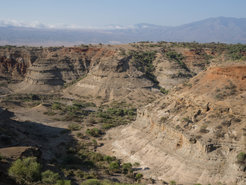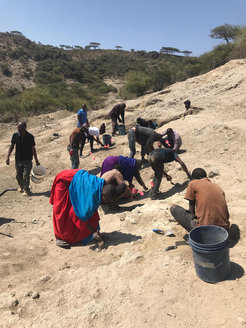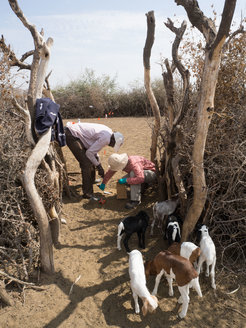Human Evolution and Environmental Change at Olduvai (Oldupai) Gorge, Tanzania
Olduvai Gorge is one of the most famous palaeoanthropological locations in Africa as a product of a series of high profile hominin fossil discoveries and its rich archaeological record which spans the past 2 million years. These characteristics mean that Olduvai Gorge is an excellent place to examine the biological and cultural emergence of our genus, Homo, as well as the environmental backdrop. Questions such as when and why did hominins change their technology and how were Oldowan and Acheulean stone tools used, as well as how changes in environment influence such shifts, are prominent in eastern African palaeoanthropology. Moreover, how do these technological changes relate to cognitive capacity, diet, and social behaviours among our ancestors? The Department of Archaeology, MPI-SHH, has teamed up with a large-scale, interdisciplinary archaeological project, “Stone Tools, Diet, and Sociality at the Dawn of Humanity” (SDS), led by Professor Julio Mercader of the University of Calgary, as well as faculty and students from the University of Dar es Salaam, in order to answer these significant questions in human evolution.

The SDS project brings together an international team of scientists (from Canada, Tanzania, Kenya, Germany, and Spain) and across multiple research disciplines, including archaeology, geology, biogeochemistry, paleoanthropology, and cultural anthropology. The research is grounded in cutting-edge field and laboratory techniques that enable us to reconstruct lacustrine and riverine sedimentary histories and changes in environments in and around Olduvai Gorge. For example, Feldspar Argon-Argon dating tools together with well dated tephra layers are being used to determine the geochronology of the study sites and the dates of technological change through time. Analytical chemistry, phytoliths, starches, macromolecules, and stone tool residue analysis are being deployed to study ancient diets as well as the habitats available to different hominin populations in the Gorge.

The Department of Archaeology of the Max Planck is contributing people and resources in order to a) examine Oldowan and Acheulean lithic assemblages, b) establish a modern reference baseline for faecal biomarkers in Olduvai Gorge, and c) reconstruct climate and vegetation changes, including the analysis of isotopes from fossilized mammalian fauna and leaf wax biomarker analysis from sediment sequences. These cutting edge approaches will ensure that we can develop multi-proxy records of hominin population change and its relationship to changes in palaeoprecipitation, temperature, and vegetation communities in the region.
Ever since Louis and Mary Leakey’s pioneering work, much research has been conducted on the stone tool technologies of Olduvai and what they mean in the context of the capacities and adaptations of some of the earliest members of our genus. However, much work remains to be done, and new excavations are revealing more details about stone tool assemblages. Our work will focus on Oldowan and Acheulean assemblages discovered in Olduvai Gorge in an attempt to examine how stone tools were made, used, and transported across the landscape. Moreover, we seek to understand the degree to which these ‘typologies’ are valid, and if key variability can, in fact, be found within these traditional groupings. When combined with the starch residue work conducted by Prof. Mercader and his team, we hope to understand more about how these technologies were developed and used by our ancestors to carve out a niche in eastern Africa.

Measurement of changes in the concentrations of specific faecal biomarkers of humans and animals contained in archaeological and sedimentary records are being increasingly used to determine the presence of different taxa, as well as their population sizes, through time. Faeces contain unique biochemical tracers that may preserve for millennia under favorable conditions. However, in order to gain better understanding of preservation processes, faecal biomarker transport, and landscape level variation in faecal accumulation, it is essential to develop modern baselines in specific geographical, climatic, and anthropological contexts. To do this, the MPI-SHH and SDS has developed an innovative baseline study, in close collaboration with local communities living in Olduvai Gorge today, which seeks to determine how faecal biomarkers are distributed across modern landscapes.
In order to understand the adaptive emergence of our early ancestors in eastern Africa it is essential to determine the environmental context and habitats available to different populations. Stable isotope analysis of leaf wax biomarkers has been promoted in marine records, as well as palaeontological layers, in eastern Africa as an important tool for reconstructing past vegetation communities and moisture availability. However, little mapping of how these parameters vary across landscapes has been carried out in the region. As a result, the MPI-SHH is contributing to ongoing work as part of SDS that seeks to sample a variety of habitats and climatic zones in the Olduvai region to determine how leaf wax carbon and hydrogen isotopes vary with landscape, geological, micro-habitat, and vegetation type. This work will then provide an important baseline for ongoing work from the Pleistocene sediments themselves being undertaken by Dr. Robert Patalano.
In addition, the Department of Archaeology will undertake stable carbon and oxygen isotope analysis on fossil fauna recovered in excavations conducted by the SDS project. A range of animals are found on the archaeological sites, representing potential scavenged or hunted prey of our ancestors. In order to further understand the habitats utilized by these hominins, we will use isotopic analysis of faunal tooth enamel to determine where these animals were living on the landscape. This will be carried out on museum and excavated collections and will involve the training of local Tanzanian students and heritage workers in the Dar es Salaam museum so that they can design similar projects in the future.
Indeed, community outreach is a major component of the SDS project, and much effort is being placed on working closely with academics and students to promote Tanzanian heritage. Most importantly, the SDS project is actively building sustainable and productive partnerships with local Maasai communities in Olduvai Gorge. Based on the Maasai’s strong desire to join in on the archaeological research, we will continue to facilitate and promote collaborations between the scientists and the local population in the years to come. The results from our first fieldwork season in summer of 2019 will be presented back to the Maasai communities in 2020 so that they can see how the work in which they have collaborated has facilitated understanding of their current landscape and activities, as well as how it might elucidate ancient human landscapes in the region in greater detail.
Related Publications
Tucker, L., Favreau, J., Itambu, M., Larter, F., Mollel, N., Mwambwiga, A., Patalano, R., Roberts, P., Soto, M., Mercader, J. 2020. Initial Assessment of Bioavailable Strontium at Oldupai Gorge, Tanzania: Potential for Early Mobility Studies. Journal of Archaeological Science. 114:105066.


